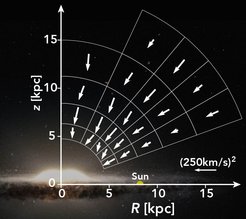The Milky Way's gravitational force field measured from RR lyrae in gaia
Wegg, C., Gerhard, O., Bieth, M., 2019, MNRAS, 485, 3296

The Gaia satellite has measured proper motions (meaning the motion across the sky) for more than a billion stars across the Galaxy. However, unfortunately for most of these stars we do not have the distances we need to turn these proper motions into velocities. RR Lyrae are a type of variable star where we can estimate accurate distances. We have therefore used a sample of almost 16,000 RR Lyrae measured by Gaia to measure the dynamics of the stars which make up the Milky Way's stellar halo.
The forces produced by the stars and gas we have see are insufficient to produce the entire force field, particularly in the outer regions there is a large amount of missing force: This missing force is the gravitational force produced by Dark Matter. By examining these forces we found that the dark matter which surrounds the Milky Way must be almost spherical in shape. This is surprising because most dark matter simulations predict the dark matter should be slightly flattened.
